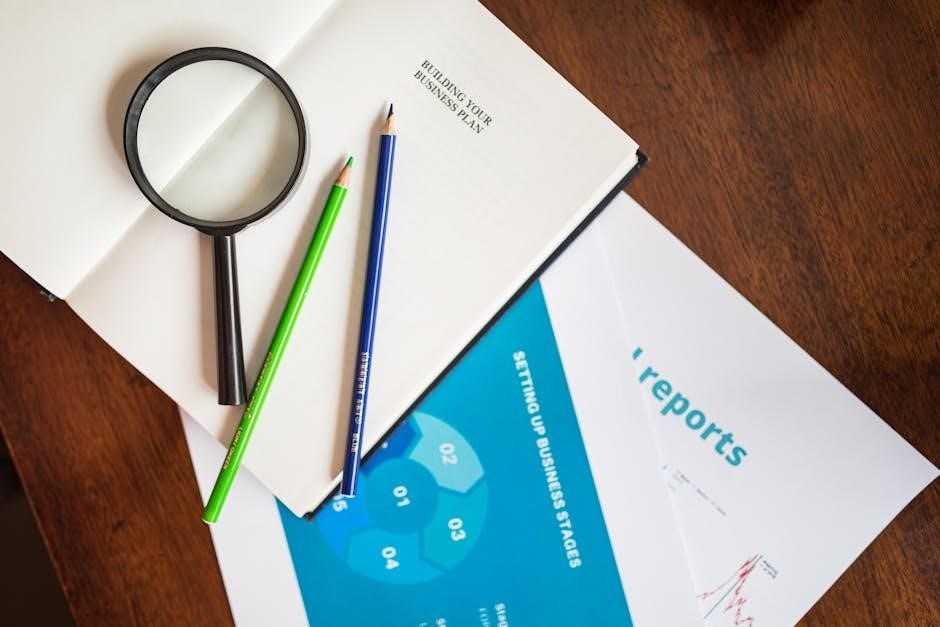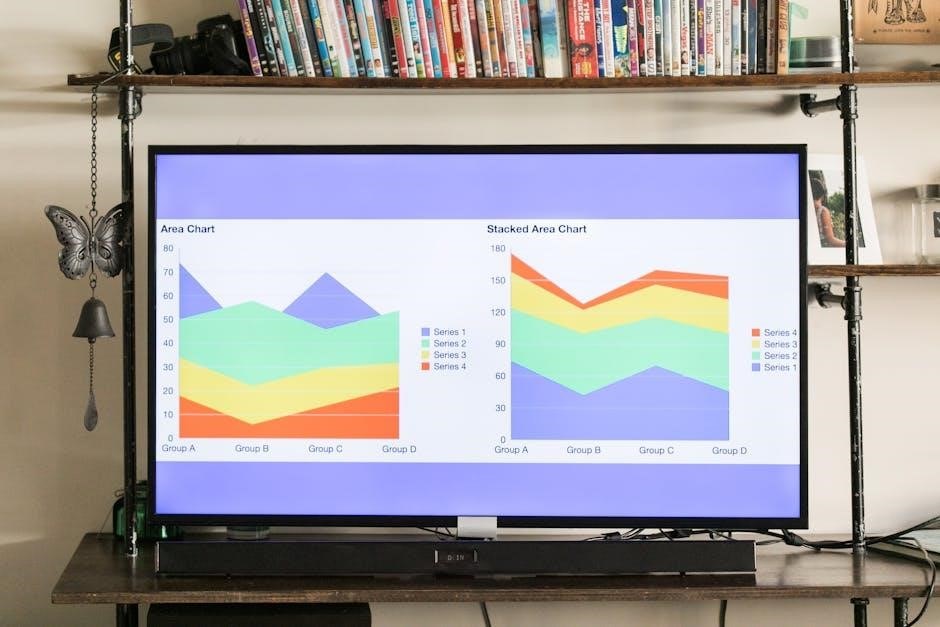A book report is a written summary of a book, providing an overview of its plot, characters, and themes. Using a PDF book report format ensures clarity and organization, helping students effectively communicate their understanding and analysis of the material. These templates are versatile, catering to different grade levels and learning styles, making the reporting process structured and engaging.
What is a Book Report?
A book report is a written summary and analysis of a book, detailing its plot, characters, themes, and the reader’s personal opinions. It provides an overview of the book’s content and examines key elements like setting, conflict, and character development. Book reports are often assigned to students to assess their understanding and critical thinking skills. They can be structured using PDF templates, which guide the organization of thoughts and ensure a professional presentation. The report typically includes a brief summary, analysis, and evaluation, helping readers grasp the book’s essence and the writer’s perspective. PDF formats make this process easy and accessible for all skill levels.
Importance of Book Reports in Education
Book reports play a vital role in education by fostering reading comprehension, critical thinking, and writing skills. They encourage students to engage deeply with texts, analyze characters and themes, and articulate their thoughts clearly. Book reports also help students develop research skills and organize their ideas logically. By completing book reports, students gain confidence in expressing opinions and insights, which enhances their communication abilities. Additionally, book reports promote a lifelong love for reading and learning, as they introduce students to diverse genres and perspectives. Using a structured format, such as a PDF template, ensures consistency and makes the learning process more accessible and efficient for students of all ages.
How to Choose the Right Book for a Report
Selecting the right book for a report involves considering the reader’s grade level, interests, and the purpose of the assignment. Choose a book that aligns with the curriculum and has sufficient depth for analysis. Ensure the book is challenging yet manageable within the given timeframe. Consider the length and complexity of the text to avoid overwhelming the reader. Teachers often provide lists of approved books, which can serve as a helpful guide. Additionally, pick a book that sparks personal interest, as this fosters engagement and makes the reporting process more enjoyable. Using a structured format, such as a PDF template, can also help guide the selection process effectively.

Understanding the Book Report Format
A book report format provides a clear structure for organizing thoughts about a book, ensuring clarity and conciseness. It typically includes sections like introduction, summary, analysis, and conclusion, guiding the reader through the content systematically. Using a PDF template can enhance readability and maintain consistency, making the report visually appealing and professional. Proper formatting helps in presenting ideas logically, allowing the reader to follow the analysis effortlessly. This structured approach ensures that all key elements of the book are covered comprehensively, making the report informative and engaging for the audience.
Key Components of a Book Report
A book report typically includes essential components that provide a thorough understanding of the book. These components often involve a summary of the plot, an analysis of characters, themes, and symbols, as well as a personal opinion or review. Additionally, including background information about the author and the book’s context can enhance the report. The structure should also incorporate clear headings and subheadings to organize the content effectively. Using a PDF format ensures that these components are presented in a visually appealing and professional manner, making the report easy to read and follow. Proper formatting is key to a successful book report.
Standard Structure for a Book Report

A standard book report follows a structured format to ensure clarity and organization. It typically begins with a title page, including the book title, author, and your name. Next, a brief introduction provides background information about the book and its author. The body includes a summary of the plot, analysis of characters, themes, and symbols. Personal opinions and critiques are also incorporated. Finally, a conclusion wraps up the report, highlighting key takeaways. Using a PDF format ensures this structure is presented neatly, with clear headings and sections. This standardized approach helps readers follow the report effortlessly, enhancing its professionalism and readability.
Differences Between a Book Report and a Book Review

Differences Between a Book Report and a Book Review
A book report and a book review are often confused but serve distinct purposes. A book report focuses on summarizing the plot, characters, and themes, providing an objective overview of the book. It is factual and structured, often following a specific format like the book report format PDF. In contrast, a book review is subjective, expressing the reader’s personal opinions and critique of the book’s quality, writing style, and impact. While a report informs, a review analyzes and evaluates. Understanding this difference helps in tailoring the content to meet the assignment’s requirements, whether it’s a detailed report or a critical review.

Elements of a Comprehensive Book Report
A comprehensive book report includes a title page, plot summary, character analysis, theme and symbolism, and personal opinion, ensuring a detailed and structured analysis of the book.
Title Page
The title page is the first element of a book report and serves as the reader’s introduction to your work. It typically includes the title of the book, the author’s name, your name, the class or course, and the submission date. The title should be bold and centered, while the remaining details are usually placed at the bottom of the page. A well-designed title page adds professionalism and clarity to your report, making it visually appealing and organized. It also helps the reader quickly identify the purpose of the document. Ensure all information is accurate and neatly formatted for a strong first impression.
The plot summary is a concise overview of the book’s main events, highlighting key characters, settings, and the central conflict. It should provide enough detail to give readers a clear understanding of the story without revealing spoilers. The summary typically includes the exposition, rising action, climax, and resolution, showcasing how the narrative unfolds. Keep it factual and objective, avoiding personal opinions or interpretations. Aim for a length of 100- to ensure brevity while covering essential plot points. This section prepares readers for the deeper analysis that follows, offering a solid foundation for understanding the book’s themes and characters.
Character Analysis
The character analysis section delves into the personalities, roles, and development of the main characters in the book. Discuss their motivations, relationships, and how they influence the plot. Highlight key traits, such as strengths, weaknesses, and transformations, to show character growth. Analyze the protagonist and antagonist, explaining their significance to the story. Use examples from the text to support your observations. This section helps readers understand how characters shape the narrative and convey the author’s message. Keep your analysis focused and relevant, ensuring it aligns with the book’s themes and plot. Aim for clarity and depth in your evaluation of the characters.
Theme and Symbolism
In a book report, analyzing the theme and symbolism is crucial to understanding the author’s message. The theme refers to the central idea or message conveyed through the story. Identify and explain how the theme is developed throughout the plot. Symbolism involves objects, colors, or events that represent abstract ideas or concepts. Discuss how these symbols contribute to the overall theme and deepen the story’s meaning. For example, a rose might symbolize love or sacrifice. Ensure your analysis connects the symbols to the broader theme, providing insights into the author’s intent and the story’s significance. Keep your explanation clear and insightful.
Personal Opinion and Review
In the personal opinion and review section of your book report, share your honest thoughts and feelings about the book. Highlight aspects you enjoyed or found disappointing, and explain how the story or characters resonated with you. Use specific examples to illustrate your points, ensuring your critique is balanced. Conclude with your overall impression and whether you recommend the book. This section offers readers insight into your personal connection with the book and its potential appeal to others.

PDF Book Report Templates
PDF book report templates provide pre-designed formats to structure your report neatly, saving time and effort. They often include sections for summaries, analyses, and reviews, ensuring organization and clarity.
Advantages of Using PDF Templates
Using PDF templates for book reports offers numerous advantages, including consistency and professionalism in presentation. They provide pre-designed layouts, ensuring all essential sections are included, such as summaries, analyses, and reviews. PDF templates save time by eliminating the need to create a structure from scratch. They are also easily customizable to suit individual or academic requirements. Additionally, PDF templates are compatible with most devices, making them accessible and sharable. They help users maintain a uniform format, reducing errors and enhancing readability. Overall, PDF templates streamline the reporting process, allowing focus on content quality while ensuring a polished final product.
Where to Find Free PDF Book Report Templates
Free PDF book report templates can be easily found online through various platforms. Microsoft Word and Google Docs offer a wide range of downloadable templates designed for book reports. Websites like Template.net and PDF Template provide an extensive collection of customizable PDF templates. Additionally, educational platforms such as Canva and Pinterest have user-friendly designs suitable for students; These templates are readily accessible, saving time and effort. They cater to different educational levels, ensuring versatility for elementary, middle, and high school students. Simply search for “free book report PDF templates” on your preferred platform to explore and download the most suitable option.
How to Customize PDF Templates
Customizing PDF templates allows you to personalize your book report to meet specific requirements. Start by selecting a suitable PDF editing tool, such as Adobe Acrobat or free alternatives like PDFescape or Smallpdf. These tools enable you to add text, insert images, and modify fonts. To begin, import the template into the chosen editor. Use text boxes or annotation tools to input your content, such as the book title, author, and your analysis. Adjust fonts and colors to maintain a professional appearance. Ensure all sections like plot summary, character analysis, and personal opinions are clearly included. After making changes, save the document as a new PDF file. Finally, preview the document to ensure proper formatting before printing or submitting it digitally.

Writing Tips for a Book Report
- Read the book carefully and take notes on key themes, characters, and events to ensure a detailed report.
- Organize your report with a clear introduction, summary, and analysis to maintain a logical flow.
- Use clear and concise language to convey your thoughts and avoid unnecessary jargon.
- Proofread your report to correct grammar, spelling, and formatting errors before submission.
How to Write a Clear and Concise Summary
Writing a clear and concise summary for a book report involves capturing the essence of the book without unnecessary details. Start by identifying the main plot, key characters, and significant events. Focus on the beginning, middle, and end, ensuring you highlight the development and resolution of conflicts. Keep your language simple and objective, avoiding personal opinions. Use a structured format, such as introducing the book and author, outlining the plot, and concluding with the book’s outcome. Edit your work to ensure clarity and accuracy, making sure it aligns with the required length and guidelines. Practice will help refine your skills in creating effective summaries.
Developing Critical Thinking in a Book Report
Developing critical thinking in a book report involves analyzing and interpreting the text deeply. Start by questioning the author’s purpose, the characters’ motivations, and the themes presented. Evaluate the strengths and weaknesses of the plot and consider the historical or cultural context. Compare and contrast ideas within the book or with other works. Identify biases or assumptions and assess the author’s arguments. Support your analysis with evidence from the text. This approach fosters a deeper understanding and demonstrates your ability to think independently. Critical thinking enhances the quality of your report and engages readers more effectively.
Common Mistakes to Avoid
When creating a book report, several common mistakes can detract from its quality. One major error is failing to follow the specified format, such as omitting required sections or ignoring word count guidelines. Another mistake is submitting a report that is overly generic, lacking personal insights or deep analysis. Plagiarism is also a serious issue; ensure all ideas are paraphrased and properly cited. Additionally, procrastination often leads to rushed, poorly written reports. Lastly, neglecting to proofread for grammar, spelling, or clarity can significantly lower the report’s professionalism. Avoiding these pitfalls ensures a polished and effective book report.

Book Report Examples and Samples
Explore various examples and samples of book reports, categorized by education levels and genres, to understand the structure and depth required for different formats.
Examples of Elementary-Level Book Reports
Elementary-level book reports are simple and focus on basic comprehension. They typically include the book title, author, a short summary, main characters, and a simple review. Students often use templates to organize their thoughts. For example, a report on The Cat in the Hat might summarize the plot, describe the characters, and share a favorite part. These reports help young readers develop writing and critical thinking skills. PDF templates are widely used to guide students in formatting their reports neatly. Examples of such reports are readily available online, showcasing how to structure and present information clearly for this age group.
Examples of Middle School-Level Book Reports
Middle school book reports are more detailed than elementary ones, focusing on plot, characters, themes, and personal insights. For instance, a report on The Giver might discuss Jonas’s journey, the importance of memory, and the book’s message about conformity. Students often use PDF templates to organize their reports, ensuring sections like summary, analysis, and review are clear. These reports demonstrate a deeper understanding of literature and improved writing skills. Examples online show how students structure their reports effectively, making them engaging and informative. PDF formats help maintain consistency and professionalism in middle school-level book reports.
Examples of High School-Level Book Reports
High school-level book reports are more analytical and detailed, requiring students to delve into themes, character development, and literary devices. For example, a report on To Kill a Mockingbird might explore themes of justice and prejudice, analyzing Scout’s growth and the symbolism of the mockingbird. PDF templates often include sections for introduction, plot summary, character analysis, themes, and personal insights. Students use these templates to organize their thoughts coherently, ensuring their reports are both informative and engaging. Examples online demonstrate how to effectively structure and present advanced literary analysis, showcasing critical thinking and writing skills. High school reports emphasize depth and insight, preparing students for college-level academic writing.

Tools and Resources for Creating Book Reports

Utilize online generators, design software, and PDF templates to streamline the creation process. Access guides for printing and sharing professional-looking reports effortlessly.
Free Online Book Report Generators
Free online book report generators offer quick and easy ways to create structured reports. Tools like Canva, Google Docs, and EdTech platforms provide customizable templates for various formats, including PDF. These generators often include drag-and-drop features, pre-designed layouts, and prompts to guide students through the reporting process. They help users organize sections like summaries, character analyses, and reviews efficiently. Many generators are user-friendly, saving time and ensuring professional-looking results. Students can also export their work in PDF format for submission. These tools are ideal for learners of all levels, promoting creativity and consistency in book report creation.
Software for Designing Book Reports
Software like Microsoft Word, Google Docs, and Canva are popular for designing book reports. These tools offer templates and formatting options to create visually appealing reports. Adobe InDesign and Scrivener provide advanced features for professional layouts. Vellum is ideal for creating eBooks and PDFs with polished designs. These programs allow users to customize fonts, add images, and structure content effectively. They also support exporting in PDF format, ensuring high-quality presentations. Whether you prefer simplicity or advanced design, these software options cater to all skill levels, helping you produce professional-looking book reports that stand out.
Guidelines for Printing and Sharing
When printing a book report in PDF format, ensure the printer settings match the document’s dimensions and orientation. Use high-quality paper for a professional appearance. Double-check that all text and images are properly aligned and visible. For sharing, save the PDF at an appropriate resolution to maintain clarity while keeping the file size manageable. Consider adding a password for security if necessary. Share via email, cloud storage, or direct download links. Ensure compatibility across devices by testing the PDF on different platforms before distribution. Proper printing and sharing ensure your book report is presented professionally and accessible to all intended readers.
A well-structured book report format PDF enhances understanding, critical thinking, and communication skills. It provides a clear framework for analyzing and presenting literary works effectively, fostering academic growth and lifelong learning.
Final Tips for a Successful Book Report
- Ensure clarity and conciseness in your writing to effectively convey your thoughts.
- Include personal opinions and insights to demonstrate critical thinking.
- Proofread for grammar, spelling, and punctuation to maintain professionalism.
- Use a book report format PDF to organize your content neatly.
- Highlight key themes, characters, and plot points to provide depth.
- Practice time management to meet deadlines without compromising quality.
- Refer to examples or templates to guide your structure and style.
By following these tips, you can create a polished and impactful book report that showcases your understanding and skills.
Encouraging Lifelong Reading and Writing
Fostering a love for reading and writing is essential for personal and academic growth. Book reports, especially when structured using a book report format PDF, help students develop critical thinking and analytical skills. By engaging with diverse texts, readers broaden their perspectives and enhance their imagination. Writing about books reinforces comprehension and encourages reflective thinking. Parents and educators can promote this by creating a supportive environment, discussing books, and celebrating progress. Lifelong reading and writing habits not only improve academic performance but also enrich personal experiences, making learning a joyful and continuous journey. Reading truly shapes minds and futures.
